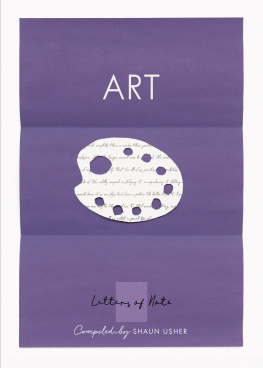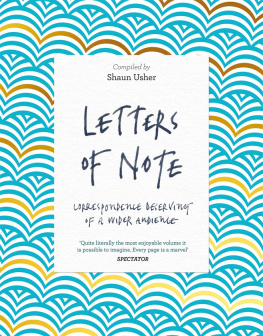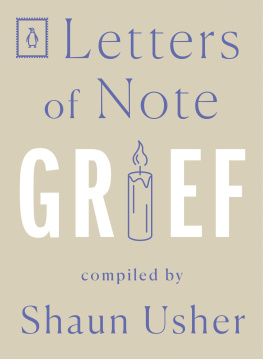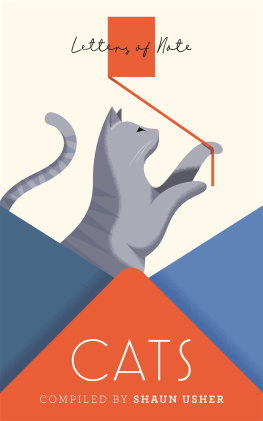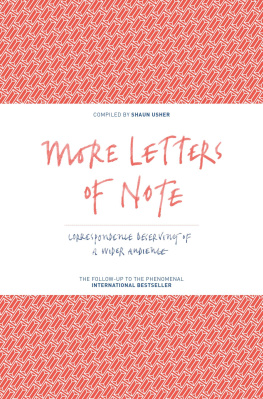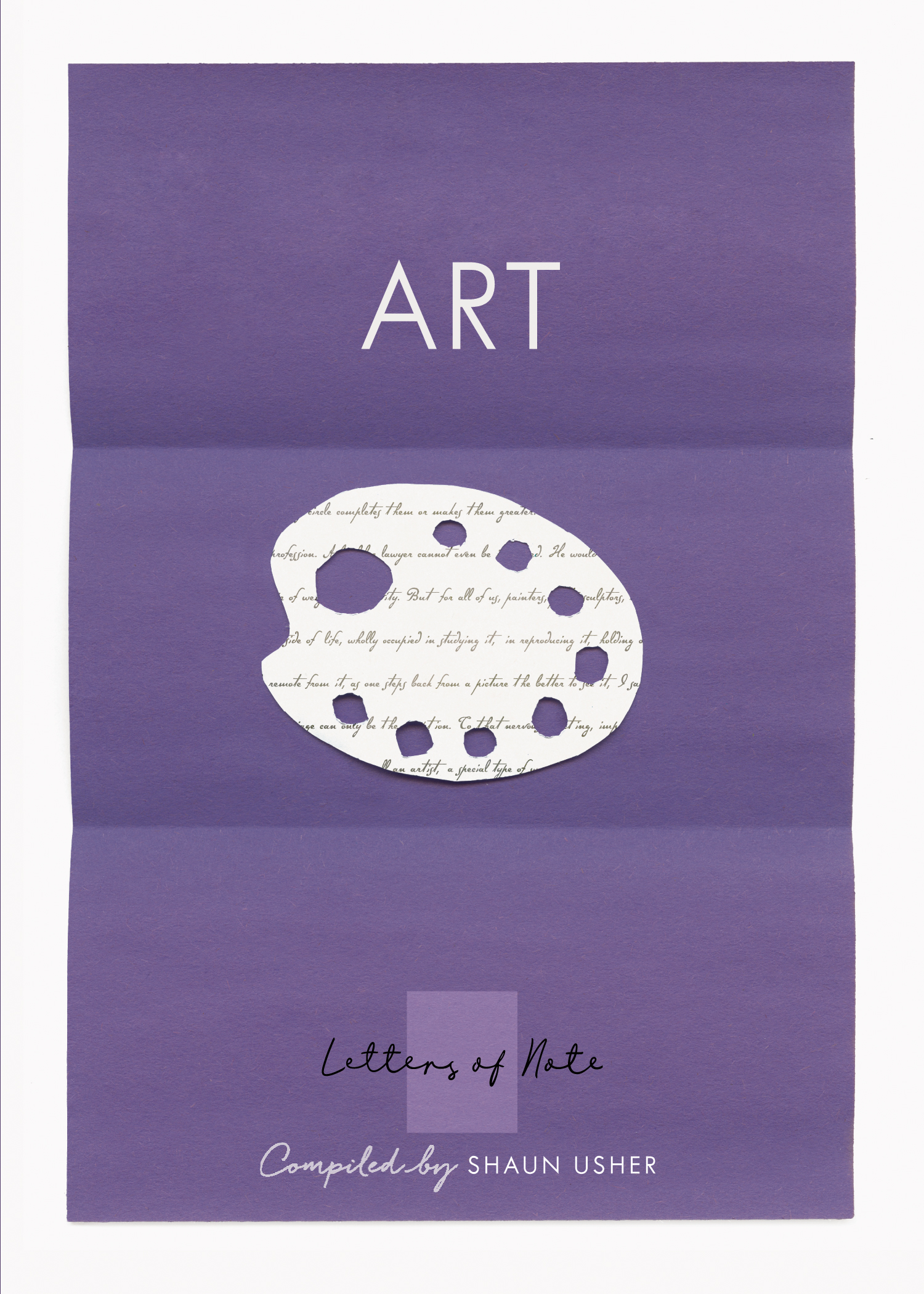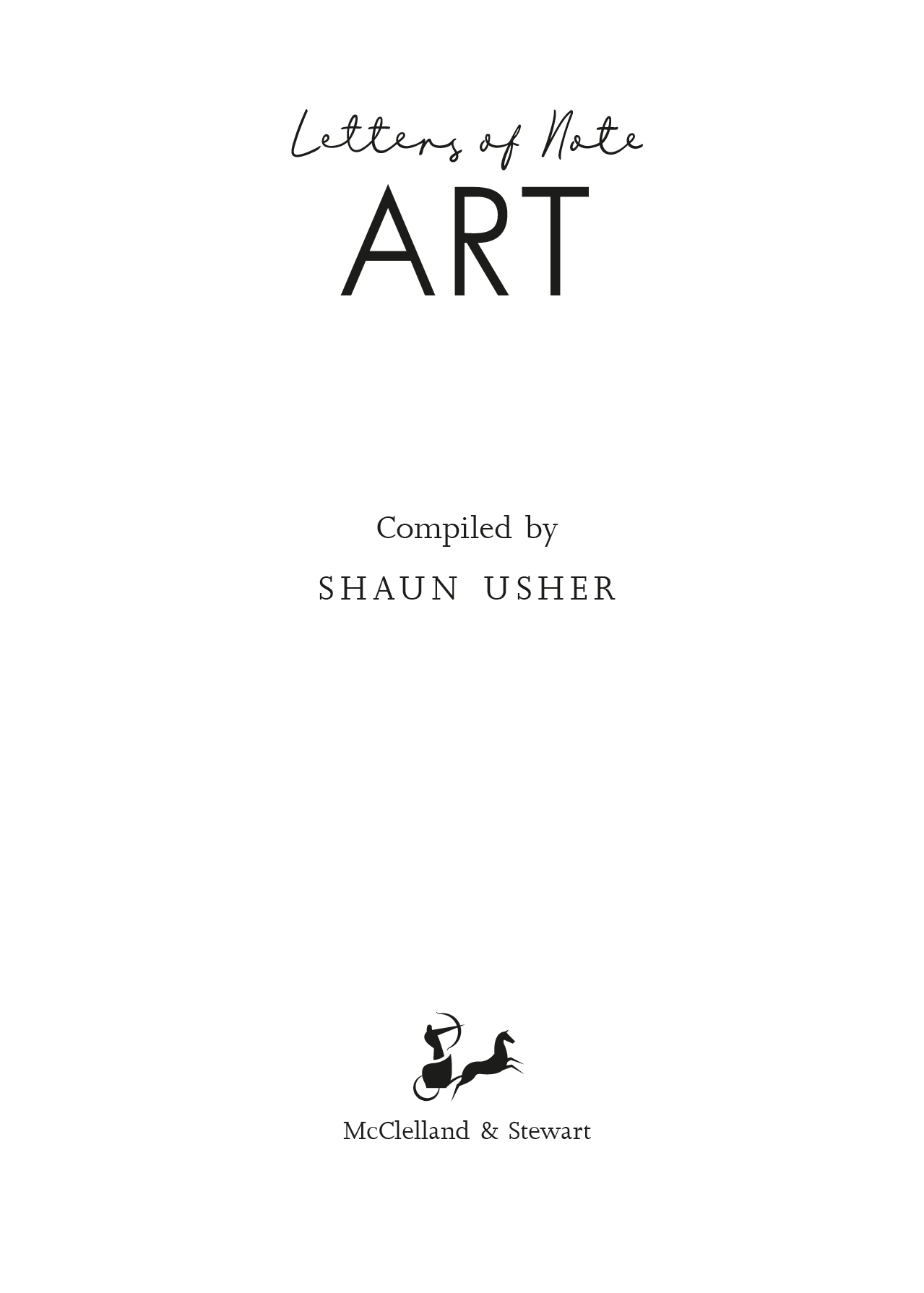Contents
Landmarks
Print Page List
Letters of Note was born in 2009 with the launch of lettersofnote.com, a website celebrating old-fashioned correspondence that has since been visited over 100 million times. The first Letters of Note volume was published in October 2013, followed later that year by the first Letters Live, an event at which world-class performers delivered remarkable letters to a live audience.
Since then, these two siblings have grown side by side, with Letters of Note becoming an international phenomenon, and Letters Live shows being staged at iconic venues around the world, from Londons Royal Albert Hall to the theatre at the Ace Hotel in Los Angeles.
You can find out more at lettersofnote.com and letterslive.com. And now you can also listen to the audio editions of the new series of Letters of Note, read by an extraordinary cast drawn from the wealth of talent that regularly takes part in the acclaimed Letters Live shows.
SHAUN USHER is a writer and sole custodian of the popular blogs lettersofnote.com and listsofnote.com. He is the author of the bestselling Letters of Note, More Letters of Note, Lists of Note, and Speeches of Note. Along with Simon Garfields To the Letter, Letters of Note inspired Letters Live, a series of live performances celebrating the enduring power of literary correspondence, with great performers reading remarkable letters to a live audience. He lives in Manchester, U.K., with his wife Karina and their two sons.
Copyright 2020 by Shaun Usher
McClelland & Stewart and colophon are registered trademarks of Penguin Random House Canada Limited.
All rights reserved. The use of any part of this publication reproduced, transmitted in any form or by any means, electronic, mechanical, photocopying, recording, or otherwise, or stored in a retrieval system, without the prior written consent of the publisheror, in case of photocopying or other reprographic copying, a licence from the Canadian Copyright Licensing Agencyis an infringement of the copyright law.
Published in Great Britain by Canongate Books Ltd.
Library and Archives Canada Cataloguing in Publication data is available upon request.
ISBN9780771049637 | Ebook ISBN9780771049644
For permission credits please see .
Series design: Kelly Hill and Andrew Roberts
Cover art: Morphart Creation / Shutterstock Images
McClelland & Stewart,
a division of Penguin Random House Canada Limited,
a Penguin Random House Company
www.penguinrandomhouse.ca
v5.4
a
For Sarah
CONTENTS
Vincent van Gogh to Theo van Gogh
Lucy R. Lippard to a Young Woman Artist
Salvador Dal to Federico Garca Lorca
Oscar Howe to Jeanne Snodgrass King
Artemisia Gentileschi to Don Antonio Ruffo
Carl Jung to Arnold Kbler
Hollis Frampton to MoMA
Mary Cassatt to Theodate Pope
Jean-Baptiste-Camille Corot to an unknown recipient
Henri Matisse to Henry Clifford
J.D. Fergusson to Margaret Morris
Harriet Hosmer to Art-Journal
Michael Grady to Alicia McCarthy
Richard Hamilton to Peter and Alison Smithson
Martin Scorsese to the New York Times
Augusta Savage to the New York World newspaper
Mark Rothko and Adolph Gottlieb to the New York Times
Yves Klein to the President of the International Conference for the Detection of Nuclear Explosions
Oscar Wilde to Marie Prescott
Adrian Piper to various editors
Michelangelo to Benedetto Varchi
Sherwood Anderson to John Anderson
Paula Modersohn-Becker to Carl Woldemar Becker
Mark Pauline to Dennis Oppenheim
Paul Nash to Margaret Nash
Lord Victor Rothschild to Laurence Fish
Frida Kahlo to Nickolas Muray
Mick Jagger and M.C. Escher
Hans Haacke to Richard Koshalek
Sol LeWitt to Eva Hesse
A letter is a time bomb, a message in a bottle, a spell, a cry for help, a story, an expression of concern, a ladle of love, a way to connect through words. This simple and brilliantly democratic art form remains a potent means of communication and, regardless of whatever technological revolution we are in the middle of, the letter lives and, like literature, it always will.
INTRODUCTION
Think of this book as a gallery.
Better still, a private gallery that fits in your pocket, with no rules to speak of. Yes, you can touch the exhibits. Of course you can take photos with the flash on. And no, you are not required to speak quietly. On the walls of this gallery can be found thirty letters of note, all of which in some way shine a light on various moments in the history of art and illuminate them for your enjoyment; most, but not all, written through the ages by artists themselves artists who momentarily put down their pencils, their paintbrushes, their chisels, and instead put pen to paper to create the windows into the art world through which you are soon to look.
Like art so often can, some of these letters act as portals to a particular time and place. Just as Constables The Hay Wain immediately transports you to the River Stour beneath a cluster of clouds one calm day in the nineteenth century, so too shall war artist Paul Nashs bleakly harrowing missive to his wife drop you onto the hellish field of battle during World War I; and just as the broad, expressive brushstrokes of Rembrandts Self-Portrait somehow reveal so much about someone you have never met, so too will Italian painter Artemisia Gentileschis defiant letter to her patron, written at a time when she was simply not meant to succeed, paint a powerful picture of its determined author.
Additionally, just hearing the voice of an artist through their letters can be an odd and thrilling experience. I can vividly remember the time I was introduced to the correspondence of Salvador Dal, whose otherworldly paintings defy description his fantastical landscapes littered with scenes that play tricks on the mind, causing the viewing experience to become almost hallucinatory. Not for one moment did I imagine that his letters would provoke a similar reaction in me. Yet here was I, letter in hand, baffled and amused in equal measure by his seemingly random talk of stray breasts and nests of anaesthetized wasps, but delighted to hear his voice loud and clear in a different medium strangely comforted to feel his art pushing through the page.
Letters offer an artist a different creative outlet, and a means by which to discuss the final product they thrust out into the world. To be able to read about their process, their fears, their excitement, is an opportunity too valuable to ignore.
Having spent a considerable portion of my adult life obsessively sifting through the correspondence of others in search of the latest masterpiece, I am firmly of the belief that some letters can and should themselves be considered works of art invaluable, often culturally significant objects to be enjoyed and appreciated by as wide an audience as possible. Which is why, hanging on the wall to my left as I write, is a framed copy of Sol LeWitts incomparable letter of encouragement to fellow artist Eva Hesse, a piece of correspondence so impactful, thought-provoking and creatively stimulating that it also happens to close the book you now hold, each of its 800 words working as hard as the individual brushstrokes of any oil painting.

